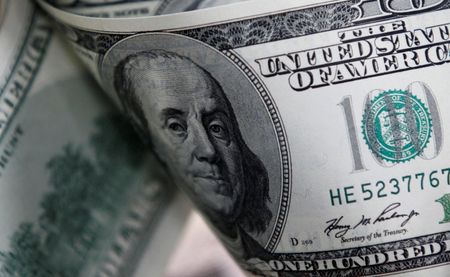By Yoruk Bahceli and Ankur Banerjee
LONDON/SINGAPORE (Reuters) -The U.S. dollar recovered on Wednesday even as investors remained nervous about attacks on Federal Reserve independence, while European shares steadied after a sharp drop a day earlier with all focus on earnings from AI leader Nvidia.
Concerns for U.S. Federal Reserve independence swirled as a lawyer for Fed Governor Lisa Cook, whose firing President Donald Trump ordered on Monday, said she would file a lawsuit against his move.
Even so, the dollar rebounded on Wednesday from its drop in the previous session and was up 0.4% against a basket of currencies by 0858 GMT.
“If you think about near-term policy and the impact, despite thinking that inflation can become unanchored when you have a less independent central bank, Cook has been dovish overall,” said Justin Onuekwusi, chief investment officer at St. James’s Place.
“I think what concerns markets overall is the persistent rhetoric on the Fed that can put the future independence of the central bank into question,” said Onuekwusi, adding that markets appeared complacent about the attendant risks to policymaking.
The two-year U.S. Treasury yield , which typically moves in step with interest rate expectations, hit its lowest since May at 3.651% in Asian trade earlier.
The yield on the 30-year bond, which bore the brunt of Tuesday’s selloff, was last unchanged at 4.91%.
Trump has repeatedly criticised Fed Chair Jerome Powell and policymakers for not cutting interest rates. Market watchers interpreted Powell’s comments at the Fed’s annual Jackson Hole symposium last week as indicating cuts could be on the way.
That has led to investors raising their bets on a rate cut next month, with traders pricing in an 84% chance of the Fed moving in September and expecting more than 100 bps of easing by June 2026.
“I think investors are focused more on the upcoming payroll print and what that means for a September rate move,” said Ben Bennett, APAC investment strategist at Legal and General Investment Management.
The pan-European STOXX 600 index was trading flat on the day after a nearly 1% drop on Tuesday, when French Prime Minister Francois Bayrou’s gamble to win backing for his deeply unpopular debt-reduction plan backfired.
Bayrou’s move to call a confidence vote on September 8 has raised the risk that the euro zone’s second largest economy could soon face another collapse of the government. However, French bonds calmed and stocks rose on Wednesday following a sharp selloff a day earlier.
“What is key is whether or not we will be able to have a budget by the end of the year,” said AXA chief economist Gilles Moec.
For the time being, markets were pricing in a repeat of last year, when the French government ultimately pushed through a budget, but market reaction could change if a new snap election were called, he added.
NVIDIA
U.S. stock futures were trading flat.
All focus turned to earnings from Nvidia later on Wednesday, which will set the tone for how tech-concentrated U.S. equity indexes, which have reached near record highs, will trade.
Data showed options traders are pricing in about a $260 billion swing in Nvidia’s market value after the firm reports earnings, where its business in China will be watched after an unusual profit-sharing deal with the Trump administration.
Caught in the crossfire of a Sino-U.S. trade war, the fate of Nvidia’s China business hangs on where the world’s two largest economies land on tariff talks and chip trade curbs.
In Asia, Japan’s long-dated government bond yields, which have been under sustained pressure in recent months, rose to fresh all-time highs on Wednesday following a weak result in the Bank of Japan’s regular debt purchase operations.
Chinese stocks, however, remain on the charge with the blue-chip stock index <.CSI300> hitting a three-year high earlier in the day, buoyed by the tech sector.
In commodities, spot gold was 0.2% lower after touching a two-week high in the previous session.
Oil prices were down 0.4% with the market on alert for fresh developments in the war in Ukraine and investors weighing hefty new U.S. tariffs on India, the world’s third-biggest crude consumer.
Both Brent crude and West Texas Intermediate crude futures (CLc1> were down nearly 30 cents at $66.94 and $62.99 respectively.
(Reporting Yoruk Bahceli and Ankur Banerjee, additional reporting by Dhara Ranasinghe; editing by Christopher Cushing, Lincoln Feast and Mark Heinrich)










